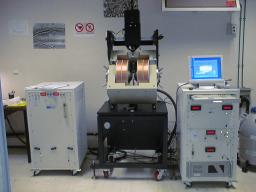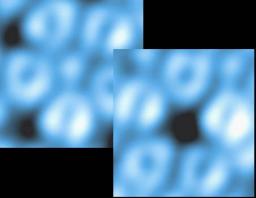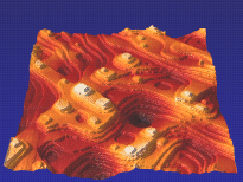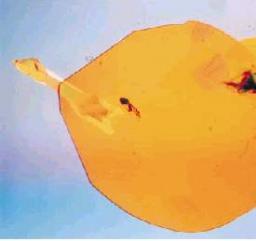2005
Nov 28, 2005
DSM/DRECAM/SPCSI - Oxides group
Spin electronics is a new field of research which associates two domains of physics: magnetism and electronics. In the last decade, effects related to spin dependent transport like giant magnetoresistance (GMR) and tunnelling magnetoresistance (TMR) in magnetic heterostructures have stimulated a considerable interest. These physical properties can be exploited in a variety of advanced devices such as highly sensitive magnetic sensors (e.g. read heads for magnetic recording) and non volatile magnetic memories (MRAM). Some ferromagnetic oxides have a 100 % spin polarization (there are half metallic) and thus are promising candidates for applications in spin electronics. The use of half metallic ferromagnets electrodes in magnetic tunnel junctions (MTJs) can lead to TMR effects much higher than those obtained with usual ferromagnetic electrodes. One of the predicted half metallic oxide is magnetite Fe3O4 which exhibits a high Curie temperature (Tc= 858 K) so that one can expect the half metallic character to remain significant at room temperature.
Nov 28, 2005
DSM/DRECAM/SPCSI - Oxides group
Spin electronics is a new field of research which associates two domains of physics: magnetism and electronics. In the last decade, effects related to spin dependent transport like giant magnetoresistance (GMR) and tunnelling magnetoresistance (TMR) in magnetic heterostructures have stimulated a considerable interest. These physical properties can be exploited in a variety of advanced devices such as highly sensitive magnetic sensors (e.g. read heads for magnetic recording) and non volatile magnetic memories (MRAM). Some ferromagnetic oxides have a 100 % spin polarization (there are half metallic) and thus are promising candidates for applications in spin electronics. The use of half metallic ferromagnets electrodes in magnetic tunnel junctions (MTJs) can lead to TMR effects much higher than those obtained with usual ferromagnetic electrodes. One of the predicted half metallic oxide is magnetite Fe3O4 which exhibits a high Curie temperature (Tc= 858 K) so that one can expect the half metallic character to remain significant at room temperature.
Aug 22, 2005
The discovery of quasicrystals in 1982 was a revolution in physics solid state. A crystal could have a 5-fold orientational symmetry prohibited by te usual crystallography. In return, its structure is aperiodic. One distinguishes quasicrystals with icosahedral symmetry (aperiodic in N=3 dimensions) and dodecagonal (N=2). The studies by x-rays and neutrons diffraction allows to describe their structure. To describe it, coordinates of atoms are numbers of the form (n+m τ, where τ is an irrational equal to the golden mean for icosaedral quasicristals). The aperiodic network can then be described in a (NxN) dimension space.
Concerning surfaces of quasicrystals, neutral helium diffraction studies and scanning tunneling microscopy (STM) images of the 5-fold surface of i-AlPdMn give evidence of wide terraces separated by step heights higher than the minimal distances between atomic planes. The surface consists of aluminium rich planes. High resolution STM images of terrasses and step sequences can be interpreted by means of the NxN=6 dimensions Katz-Gratias polyhedral model. As for usual ordered alloy crystals (Cu3Au, Cu83Pd17...) terraces correspond to plans rich in segregating element (aluminium). However, the in plane density being not constant, it is necessary to add a selecting criterion on the density of the topmost and second planes.
Jul 22, 2005
The silicon carbide (SiC) is an interesting semiconductor for electronics because of its capacity to be functioned at high temperature. Another interesting property of this materials is the capacity that on its surface under certain conditions to organize itself in formed atomic dimer lines of which the length can exceed the micron. Spacing can be adjusted by a heat treatment. Thus it is possible to realize a super-lattice of atomic lines massively parallel. These highly regular structures could be used as support to build nanostructures (Spcsi- Univ Paris XI).
http://www.sima.u-psud.fr/sima
Jul 22, 2005
The formation of structural patterns on a nanometric scale is approached using the growth of thin layers. This approach is based on comprehension, until the atomic scale, of the relevant kinetic processes. A judicious exploitation of the energy hierarchy of these mechanisms led, by spontaneous organization of the matter deposited, to the emergence of a periodic arrangement of nanostructures with a specific geometry. These nanostructurated surfaces can then be used as matrices in order to control the growth of other materials. Thus, in only one stage, a great density of identical nano-objects is elaborate, starting point with the exploration of their physical properties. In addition to the growth techniques, the interaction of ions or even of light with surfaces can also lead to a formation of nanometric patterns.
Jul 22, 2005
The emergence of the organic semiconductors in the electronics area and the technologies of information is now on a reality. Small molecules or polymers, these materials can be to substitute for silicon in the realization of transistors, photovoltaic cells or electroluminescent diodes. Easy to deposit, mechanically flexible, they are inexpensive. Their structure can be adjusted so as to obtain the desired properties. Lastly, the recent possibility to obtain single crystals of great purity opens vast prospects towards "Plastic Electronics".
Nov 28, 2005
DSM/DRECAM/SPCSI - Oxides group
Spin electronics is a new field of research which associates two domains of physics: magnetism and electronics. In the last decade, effects related to spin dependent transport like giant magnetoresistance (GMR) and tunnelling magnetoresistance (TMR) in magnetic heterostructures have stimulated a considerable interest. These physical properties can be exploited in a variety of advanced devices such as highly sensitive magnetic sensors (e.g. read heads for magnetic recording) and non volatile magnetic memories (MRAM). Some ferromagnetic oxides have a 100 % spin polarization (there are half metallic) and thus are promising candidates for applications in spin electronics. The use of half metallic ferromagnets electrodes in magnetic tunnel junctions (MTJs) can lead to TMR effects much higher than those obtained with usual ferromagnetic electrodes. One of the predicted half metallic oxide is magnetite Fe3O4 which exhibits a high Curie temperature (Tc= 858 K) so that one can expect the half metallic character to remain significant at room temperature.















